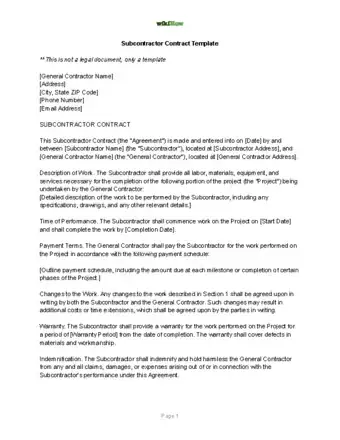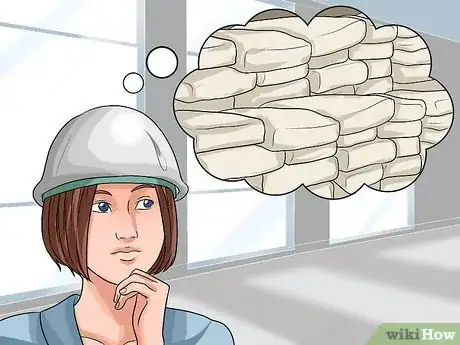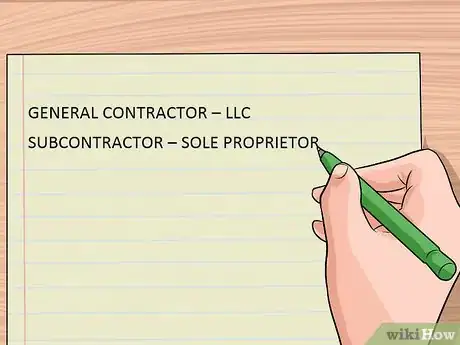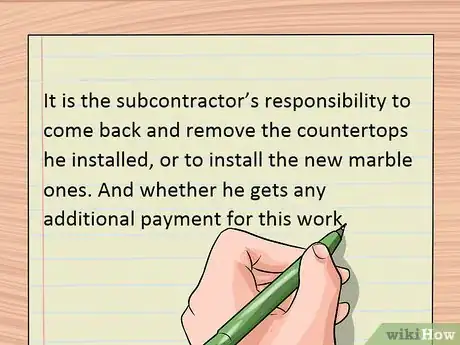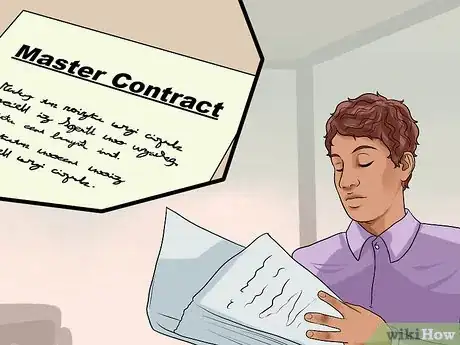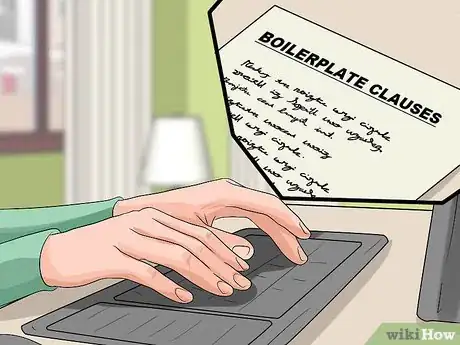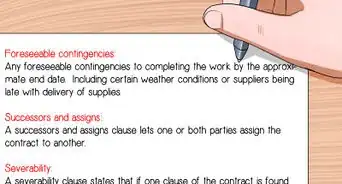This article was written by Jennifer Mueller, JD. Jennifer Mueller is an in-house legal expert at wikiHow. Jennifer reviews, fact-checks, and evaluates wikiHow's legal content to ensure thoroughness and accuracy. She received her JD from Indiana University Maurer School of Law in 2006.
This article has been viewed 65,603 times.
When a general contractor hires someone else to do parts of the work he was contracted to do, that person becomes a subcontractor. The subcontractor answers to the general contractor rather than directly to the property owner or person who hired the general contractor. The contract between the subcontractor and the general contractor establishes all aspects of their agreement, including the scope of the work the subcontractor will do, who will provide materials for him to complete the work, how much he will be paid, and how long it will take to complete.[1]
Steps
Subcontractor Contract Template
Negotiating Your Agreement
-
1Determine the scope of the work the subcontractor will do. Both parties must have an understanding of the specific work to be done, and how it will fit in with the contractor's existing schedule and deadlines.
- Both parties also should have a clear understanding of what the subcontractor is capable of doing, particularly within whatever time constraints are presented by the project.
-
2Estimate time for completion of the work. The general contractor and subcontractor need to work together to come up with a realistic expectation of how long it will take to finish the job, taking into consideration any excusable delays such as rain that might slow completion.
- As the general contractor, you should make sure that the subcontractor's deadlines are well before your deadlines laid out in your master contract.
- This way, you can be sure that if anything happens, or if the subcontractor doesn't do the job according to specifications, you have time to correct the problem.[2]
Advertisement -
3Decide who will provide materials and when they will be delivered. If the subcontractor needs separate materials to complete her part of the project, she and the general contractor must decide whether she or the general contractor is responsible for purchasing those materials.
- Often the subcontractor will be responsible for providing her own materials, but in some cases particular materials may have already been purchased to conform to the wishes of the property owner.[3]
-
4Discuss payment methods and terms. Agree upon the total amount the general contractor will pay the subcontractor, then decide when and how it will be paid.
-
5Consider what should happen in the event of a breach of contract. If the general contractor plans to pass on to the subcontractor any costs or penalties included in his contract, this should be discussed.
- As a subcontractor, you shouldn't agree to a general contractor's form agreement without discussing or negotiating the provisions.
- The standard form agreement a general contractor uses was drawn up to their benefit. If you feel uncomfortable or pressured, have an attorney take a look at it.
- Decide what to do if changes to the work or schedule for the project must be made. Both parties should agree on how much notice should be provided.
Drafting Your Agreement
-
1Identify the parties. Open the agreement by providing the individual names of the two people signing the agreement, as well as business names if applicable. Include contact information such as addresses and phone numbers for both the general contractor and the subcontractor.
- Include the legal status of all parties. For example, if the contractor is an LLC, but the subcontractor is a sole proprietor, these businesses should be identified in the contract.
- The initial part of the contract also should mention the project the subcontractor is being hired to work on and reference the master or prime contract.
- In this section you also may want to define the relationship of the parties and clarify that the subcontractor is an independent contractor and not an employee of the general contractor.
- Deliniate who employees are working for if there are two tiers of workers on the site.[4]
-
2Define the scope of work to be done. Provide a description of exactly what the subcontractor is expected to do for the general contractor.
- You want these descriptions to be as specific as possible, because these clauses put the subcontractor on notice as to the contractor's expectations.
- If the property owner doesn't like the subcontractor's work, the contract should make it clear under what circumstances the subcontractor is expected to fix it to the owner's expectations.[5]
-
3List the rights and duties of each party. If you've agreed that specific parties will be responsible for inspections or for completion of any prerequisites, those should be included in the contract.
- For example, you might want to make it clear in the contract that the subcontractor is providing their own worker's compensation insurance and liability insurance.
- As a general contractor, you should consider including a clause that preserves your right to inspect the subcontractor's work at any time and ensure it conforms to expectations.[6]
-
4Create work completion and payment schedules. Place the subcontractor's work into the context of the general contractor's overall schedule and provide deadlines for each phase of work to be completed.
- Specify the rate of pay in the contract and decide if you’re going to create milestones for payment.
- For example, if you are going to pay the subcontractor $2,000 to paint the house you're building, you might pay $500 for every 25 percent of the house that's painted.[7]
- Rather than specific milestones, you may pay the subcontractor a set amount each week, or make weekly payments provided a certain number of hours are worked.[8]
- Typically you will list the total payment amount, and then provide the schedule of payments to be made throughout the project as percentages of that total.[9]
- Consider including a clause making time of the essence, and penalizing the subcontractor for any delays caused by the subcontractor's failure to adhere to the schedule required by the general contractor.[10]
-
5Provide warranty and indemnity clauses. The subcontractor typically warrants her work against defects in material or craftsmanship for a number of years, and holds the general contractor harmless from claims or losses connected to the work she performs.
- Typically the subcontractor will warrant that they’re providing quality work in a professional manner.[11]
- Indemnification clauses shouldn't be one sided. If the subcontractor indemnifies the general contractor against claims or losses from her work, the general contractor should likewise indemnify the subcontractor.
- Although it is typical for a subcontractor to assume any damages or penalties related to their work, watch out for "pass-through" clauses.
- Likewise, subcontractors should avoid signing broad indemnity clauses that impose liability on them for all claims and damages, even those caused by the general contractor's own negligence.
-
6Provide methods by which the contract can be terminated. Typically, the subcontractor agreement can be terminated by the general contractor for the same reasons the owner can terminate the master or prime contract.
- If such a clause is used, the master contract should be attached as an exhibit to the subcontractor's contract and incorporated by reference.
- Include the effective dates of the contract, along with a final date for completion of the project.
-
7Include any necessary miscellaneous provisions. Nearly every contract includes clauses known as "boilerplate provisions," which cover issues such as what state's law governs the contract and where a lawsuit for breach of contract can be filed.
- These clauses are referred to as "miscellaneous" or "boilerplate" because they apply to nearly any contract regardless of the substance.
- For example, the agreement may include a clause that the parties agree to submit to mediation or binding arbitration in the event of a contract breach or dispute.
-
8Sign your agreement. Both the subcontractor and the general contractor must sign the agreement for it to be legally binding and enforceable.
Warnings
- If you are a general contractor and want to bring a subcontractor on board to help with a project, thoroughly review your master contract beforehand and make sure it allows the use of subcontractors. If it doesn't, then you will be solely responsible for any defects in the subcontractor's work.[12]⧼thumbs_response⧽
- If you are a subcontractor, be on the lookout for payment conditions in the payment clause. Often general contractors will use a form that states you will not get paid until the property owner has paid the general contractor under the master contract. If the general contractor insists on such a condition, make sure you've at least seen the master contract and understand when the general contractor will be getting paid.⧼thumbs_response⧽
References
- ↑ https://www.rocketlawyer.com/document/subcontractor-agreement.rl
- ↑ https://lessaccounting.com/blog/subcontractor-agreements/#
- ↑ http://www.agc-ca.org/uploadedFiles/Member_Services/Legal_Information/Contract-Sample-PDFs/AGCC-04%20-%202013%20-%20SAMPLE.pdf
- ↑ https://lessaccounting.com/blog/subcontractor-agreements/#
- ↑ https://lessaccounting.com/blog/subcontractor-agreements/#
- ↑ http://www.agc-ca.org/uploadedFiles/Member_Services/Legal_Information/Contract-Sample-PDFs/AGCC-04%20-%202013%20-%20SAMPLE.pdf
- ↑ https://lessaccounting.com/blog/subcontractor-agreements/#
- ↑ https://lessaccounting.com/blog/subcontractor-agreements/#
- ↑ http://www.agc-ca.org/uploadedFiles/Member_Services/Legal_Information/Contract-Sample-PDFs/AGCC-04%20-%202013%20-%20SAMPLE.pdf
